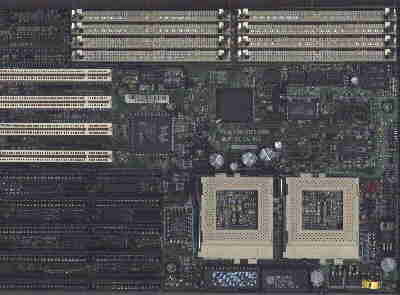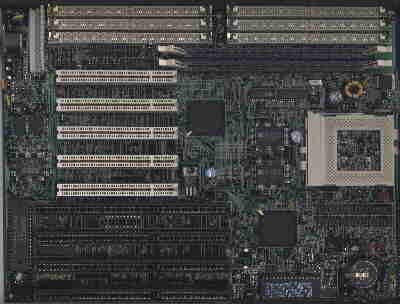Review of Socket 7 PCI Motherboards
Tyan
Tyan S1564D 'Tomcat IV'
As it was with the Tomcat III, the newest dual Pentium board from Tyan has similar features: Intel 430HX, 512 kB PB-Cache, four memory banks, four PCI / five ISA slots and switching regulators. But no support for 75 or 83 MHz bus clock. If you take into account that such a board is particularly made for server systems you can understand why Tyan did not implement higher bus clocking. Tyan is known for excellent reliability and obviously they decided to remain on the 'safe shore' of 66 MHz. All tests ran without any difficulties, I was surprised that my 'memory mix' consisting of 2x 32 MB EDO, 4x 16 MB EDO (2x 2k and 2x 4k refresh) as well as 2x 4 MB FPM (total of 136 MB) worked as well. Please consider that this mix contains of EDO and FPM, 16-chip, 12-chip, 8-chip and 2-chip modules just as symmetric and asymmetric equipped types! You will rarely find such a fine motherboard. I would have loved testing larger memory modules but had none available here, sorry. Design and quality are excellent, you are able to use all four PCI slots in full length. Winbench results don't differ by using two processors, because a second CPU will just push up applications running simultaneously, but not the primary. You will need to obtain multiprocessor software in this case.
Dual socket 7, baby AT format; AT power supply; Intel 430HX; 5x ISA, 4x PCI; 8x SIMM; Award flash BIOS; 512 kB PB-Cache (6 ns); external frequencies: 50, 60, 66 MHz; BF2 jumper missing, I/O chip: SMC; busmaster DMA or PIO 4 onboard; FDC onboard; 2x serial 16550; 1x EPP/ECP parallel; 1x PS/2 mouse (without cable); 1x USB (without cable); IrDA support; ECC/parity support; two TAGRAMs allow cacheable area of 512 MB; core voltages: 3.2V, 2.9V, 2.8V.
Tyan S1571 'Titan Turbo'
To my knowledge this is the first board from Tyan supporting 75 and 83 MHz. Equipped with Intel's 430TX chipset and 512 kB of L2 Cache, the performance of all CPUs running at 66 MHz bus clock is quite bad, there's a lot to be improved. I hope it's due to the early revision and BIOS that the modes of 75 and 83 MHz are extremly unstable as well. Neither the M2 at 187 MHz nor AMDs K6 at 250 MHz were reliable. Even the slow motion memory timings were as shaky, what a pity. The quality of this Baby AT board is very good as always; SDRAM sockets are good as well, they help to eject the module when opening the locks. The jumper descriptions are okay, but why still jumpers? Other companies have more elegant methods like dip switches or even the possibility of setting clock frequencies in the system BIOS (ABit). Very cool is the amount of memory slots. 6x PS/2 and 2x DIMM are waiting to be equipped. But in most cases it is not very clever to equip the 430TX chipset with more than 64 MB, since more can't be 'cached'. There should be some time for working on the higher external frequencies. The various memory banks as well as the 4 ISA and 5 PCI slots are typical for Tyan and a buying argument for many people. I will update this page as soon as I get a newer revision of this board. The board's layout is excellent, I think it could be worth waiting for the final revision when performance will be much better - let us hope so.
Baby AT format; AT power supply; Intel 430TX; 4x ISA, 5x PCI; 6x SIMM, 2x DIMM; Award flash BIOS; 512 kB PB-Cache (6 ns); external frequencies: 60, 66, 75, 83 MHz (unstable over 66 MHz); BF2 jumper equipped; I/O chip: SMC; busmaster Ultra DMA 2 or PIO 4 onboard; FDC onboard; 2x serial 16550; 1x EPP/ECP parallel; 1x PS/2 mouse (without cable); 1x USB (without cable); IrDA support; core voltages: 3.5V, 3.4V, 3.3V, 3.2V, 3.1V, 3.0V, 2.9V, 2.8V, 2.7V, 2.6V, 2.5V, 2.4V, 2.3V, 2.2V, 2.1V, 2.0V.
Get Tom's Hardware's best news and in-depth reviews, straight to your inbox.

Patrick Schmid was the editor-in-chief for Tom's Hardware from 2005 to 2006. He wrote numerous articles on a wide range of hardware topics, including storage, CPUs, and system builds.

